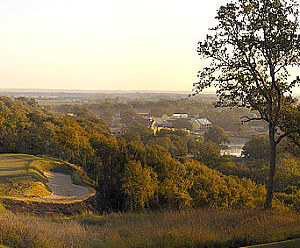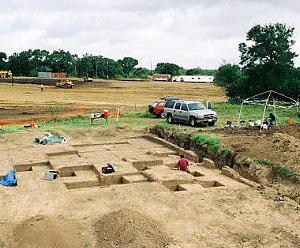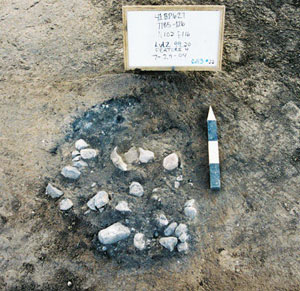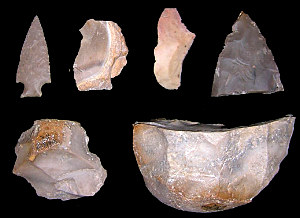McKinney Roughs: Archaic Campers
on the Colorado River
|
For centuries, native peoples and later travelers have frequented the broad and fertile Colorado River valley southeast of Austin in eastern Bastrop County, an area rich in resources and varied in terrain. Here the rugged Edwards Plateau gives way to gently rolling hills, grassland prairies, and woodlands—even a anomalous swath of tall Loblolly pines, a sight more typical of the Pineywoods to the east. For people who made their living by hunting animals and gathering wild plants, these varied environments in close proximity offered a wealth of natural resources. For visitors today, nature's diversity provides a host of recreational opportunities amid fertile farmlands. The story of the McKinney Roughs site (41BP627) begins some 2100 years ago when a succession of ancient peoples began camping on a small knoll in the Colorado floodplain. The story ends—or perhaps begins again—with the development and construction of a major resort hotel in nearly the same location. Visitors today park their cars close to the area where ancient campfires once burned. Fortunately, the site was identified and the area avoided during the development, allowing a large-scale archeological investigation and recovery of evidence. A Window in TimeMcKinney Roughs is a remarkably well-preserved site that was frequented by prehistoric campers in the final stages of the Archaic period. On at least three occasions from about 2100 to 850 years ago, prehistoric peoples camped on the knoll for brief periods of time while hunting and gathering mussels from the river, deer from the forest edge, and a variety of wild plants. The archeological site developed under relatively rare circumstances: materials left behind by these small prehistoric groups were quickly covered by fine flood sediments that sealed and preserved the site much as it was when the occupants walked away for the last time. Though most of the perishable camp debris—materials made of plants, hides, and bone—decayed and turned to dust, other more durable supplies and camp features including stone tools, fireplaces, cooking ovens, and mussel shell were left in place. Over the centuries, the camp deposits remained buried, and might have remained so for centuries more, had not a resort hotel been constructed near the site. The planning and development of the Hyatt Regency Lost Pines Resort near Bastrop triggered a series of events leading to the site's discovery and excavation. Archeologists from SWCA Environmental Consultants in Austin were contracted to conduct an archeological survey of the 635-acre hotel project area to locate and assess cultural resources—prehistoric or historic period archeological sites—that could be affected by the development. A number of sites were identified, among them 41BP627, the prehistoric campsite that would later be designated the McKinney Roughs site. The site was initially recognized when burned rocks—remains of ancient hearths—and stone tools were found in exploratory archeological trenches excavated through the site. Subsequent test pits exposed small views of what appeared to be ancient ground surfaces, buried by flood deposits from the nearby Colorado River. Large-scale excavations followed, allowing the exposure of campsites preserved in place and revealing a small window on prehistoric society. Unlike many other archeological sites, which typically have mixed or overprinted deposits reflecting multiple occupations, several camp surfaces at the McKinney Roughs site appear to have been rapidly covered over and preserved in place as singular occupations. The time period and culture represented at the McKinney Roughs site—the Transitional Archaic—is also significant, as there are few excavated sites with intact deposits dating to that time interval. Across the region and beyond, Transitional Archaic hunters used small chipped-stone projectile tips, among them Darl points. Researchers see Darl as a transitional style between dart points and arrow points, the latter considered the hallmark of the subsequent Late Prehistoric period when bow and arrow technology came into widespread use. At McKinney Roughs, Darl points serve as time markers, or "index fossils," dating the artifacts and features comprising the best-preserved and most significant portion of the site, a camp layer dating to roughly 850 to 900 years years ago. The small camp documented near the Colorado River was positioned in time and place at a critical juncture in regional prehistory, as cultural interactions between native groups were increasing and sweeping changes were underway. Radiocarbon dates for the site—notably later than are commonly attributed to Darl occupations—are helping us reconsider the timing of these changes within a regional context. From a more localized perspective, artifacts and feature evidence from the site provide an intimate glimpse of life at one small camp on the eve of the Late Prehistoric. In this ExhibitThe following sections provide a more-detailed look at the McKinney Roughs site, including the local environment and time period (Site Setting) and the data recovery process (Archeological Investigations). The Darl Component explains one of the most significant aspects of the site, traces of an intact, well-preserved encampment preserved much as it had been left 900 years ago. The Conclusions section, McKinney Roughs Site —Its Meaning and Significance, summarizes the site findings from a broader perspective and how it has contributed to our understanding of prehistory. |
|



